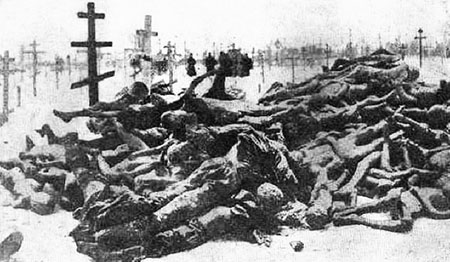The Fate of Those that Stayed

Stalin's Forced Famine 1933
7 Million People Died
Germans who remained in Russia after 1914 found it increasingly difficult to leave and even more difficult to stay. As World War I went on, the Russian economy began to collapse, leading to both the Russian and Bolshevik revolutions. The Czar, Nicolas II, was overthrown in the Russian revolution and Lenin had come to power with the Bolshevik revolution.
The war was going poorly for Russia, people were starving and the economy was in shambles. Lenin had promised an end to the war, redistribution of land to the peasants and improvements to working conditions in the industrial cities, and was under pressure to deliver. To end the war, Russia agreed to the Treaty of Brest-Litovsk in 1918. The terms were harsh, but Lenin was now free to execute his vision domestically.
In Ukraine, there was opposition to the Bolsheviks. Lenin’s Red Army began to move south, opposed by the White Army, which was supported by the US, Britian and France. In truth, the White Army was made up of a number of different factions whose common bond was the desire to defeat the Bolsheviks. They lacked a central command and leader. The Bolsheviks effectively labeled any opposition as aristocrats. After centuries of aristocratic oppression, many Russians did not want to put the Czar and the church back in power. In the end, the White Army lost and Bolsheviks gained control.
After Lenin’s death in 1924, Joseph Stalin ruled Russia with an iron hand and things went from bad to worse. Anyone owning 24 acres or more lost their land, homes and possessions to collectivization. Anyone opposing collectivization was denounced and deported to Siberia. Those who stayed were reduced from independent farmers to workers on large collective farms.
Like Catherine the Great, Stalin wanted to modernize Russia with a five-year plan to rapidly industrialize the country. Far worse than any Czar, Stalin’s plan was cruel and ruthless. In 1932-33 he ordered all grain produced in Ukraine be collected and sold on the international market to generate cash. By January 1933 there was simply no food to feed the people of Ukraine.
Despite desperate calls for aid, Stalin sealed off the border to prevent food from entering Ukraine and sent troops door-to-door, seizing any stored food. Anyone caught stealing even wheat stubble could be shot. By the spring of 1933, an estimated 25,000 people a day were dying of starvation. To the international community, Russia denied that there was a famine, and aid to the starving was not allowed into Ukraine. Western governments interested in selling industrial equipment to Russia chose not to get involved. In all, 7 million people died of starvation during Stalin’s forced famine.
The final blow to the German communities in Russia came in 1941. Fearing people of German descent would side with German troops, Stalin ordered that all persons of German descent deported to camps in Siberia.
Those that Stayed

